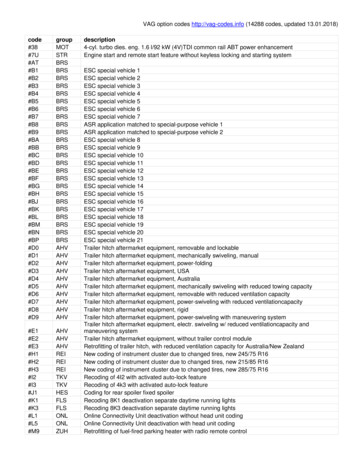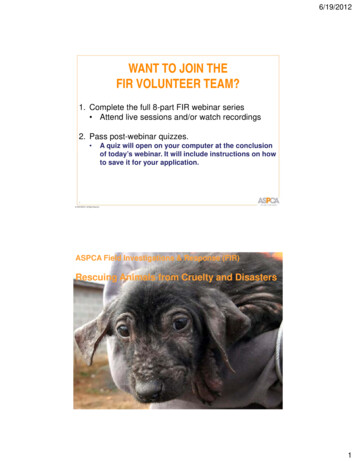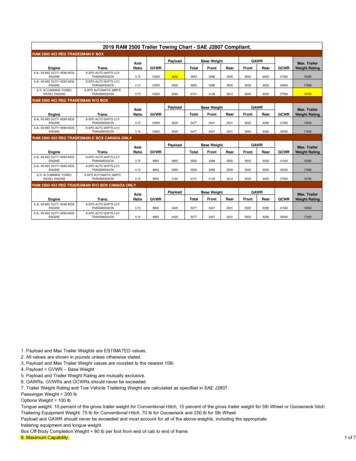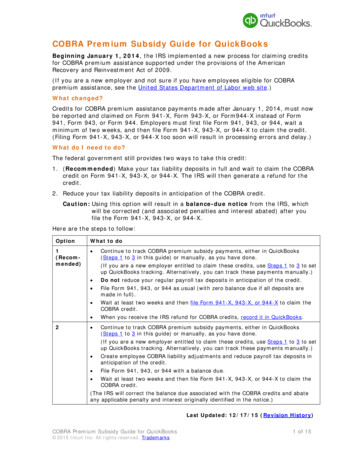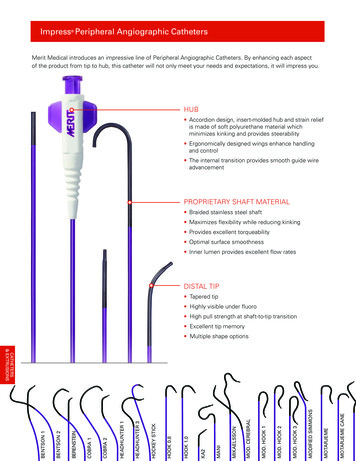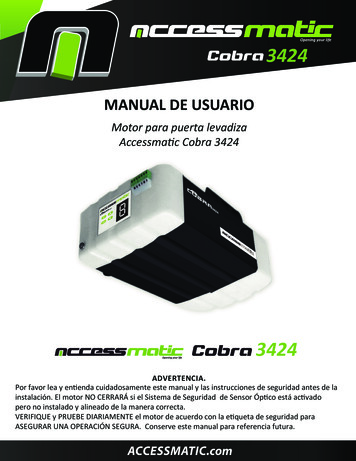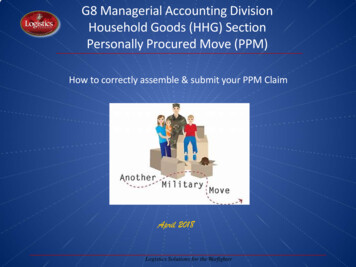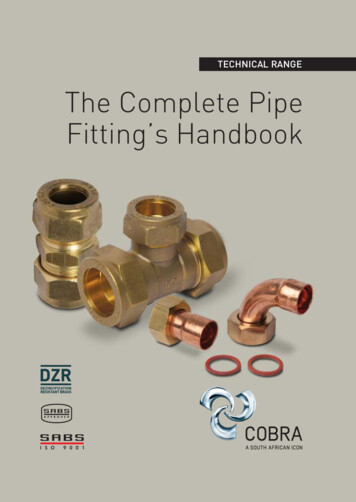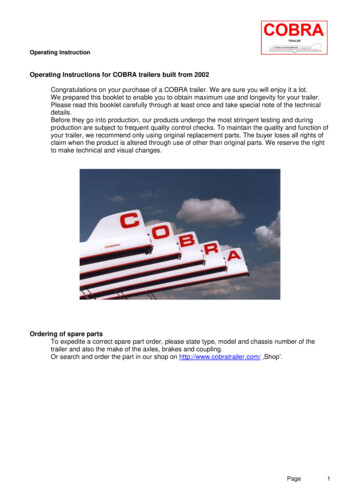
Transcription
Operating InstructionOperating Instructions for COBRA trailers built from 2002Congratulations on your purchase of a COBRA trailer. We are sure you will enjoy it a lot.We prepared this booklet to enable you to obtain maximum use and longevity for your trailer.Please read this booklet carefully through at least once and take special note of the technicaldetails.Before they go into production, our products undergo the most stringent testing and duringproduction are subject to frequent quality control checks. To maintain the quality and function ofyour trailer, we recommend only using original replacement parts. The buyer loses all rights ofclaim when the product is altered through use of other than original parts. We reserve the rightto make technical and visual changes.Ordering of spare partsTo expedite a correct spare part order, please state type, model and chassis number of thetrailer and also the make of the axles, brakes and coupling.Or search and order the part in our shop on http://www.cobratrailer.com/ ‚Shop’.Page1
Operating InstructionService and Warranty Conditions1. Safety1.1 Symbols1.2. Proper Use1.3 Safety-conscious operation1.4 Organizational Measures1.5 Maintenance and Repair1.6 Safety during maintenance and assembly works1.7 Mounting works on the chassis2. Signage3. Operation3.1 Controls before driving3.2 Coupling of the trailer3.3 Disconnecting the trailer4. Loading4.1 Nose weight4.2 Loading and unloading4.3 Load4.4 Securing of loads and Adjustment4.5. Securing of fixtures in empty trailer (empty run)5. Operation of the units5.1 Hand brake5.2 Overrun brake5.3 Axles5.4 Tyres5.5 Changing of a wheel5.6 Spare wheel6. Brakes6.1 General6.2 Readjustment of ALKO wheel brakes6.3 Brake pads6.4 Security notes for brake systems7. Electrical system7.1 Connector assignment 7-pin7.2 Connector assignment 13-pin8. Accessories8.1 Swing down supports stands (crank supports)9. Support and maintenance9.1 Galvanized parts9.2 Aluminium9.3 Fibreglas Parts9.4 Operating the Clamshell9.5 Fittings and fixtures for glider10. Lubrication plan10.1 Overrun system10.2 Bell crank lever10.3 Drawbar bolt for V-drawbar with fifth wheel trailer10.4 Joints, compensation scales, Bowden cables10.5 Ball-head coupling11 . General11.1 Driving11.2 Braking behaviour11.3 Use in winter and rain11.4 Speed limit11.5 TyresPage 3 - 4InspectionsReplacement of Lift arms / Spare PartsPage 16Page 17Page 5Page 5Page 5Page 6Page 6Page 6Page 6Page 6Page 7Page 7Page 7Page 8Page 8Page 8Page 8Page 8Page 9Page 9Page 9Page 10Page 10Page 10Page 11Page 11Page 11Page 15Page 12Page 12Page 12Page 13Page 13Page 13Page 13Page 13Page 14Page 14Page 14Page 14Page 14Page 15Page 15Page 15Page 15Page 15Page2
Operating InstructionFrom the initial day of purchase on, the Spindelberger GmbH warrants the new COBRA trailer for aperiod of two years when it is properly used and when the maintenance and inspection provisionsare complied with. This warranty applies to the territory of the Federal Republic of Germany;moreover, this warranty does not affect the legal claims from the warranty law.The warranty includes:Replacement, or at the manufacturer’s discretion, repair of the construction or material defect andprovided that the trailer was used for its intended purpose and within its defined limits.Any repair or replacement carried out under the stated conditions does not extend the warrantyperiod.Conditions:Servicing in accordance with the instructions contained in this booklet must have been carried out.For repair works a use of original replacement parts is compulsory.Any repair must be carried out by an accredited COBRA agent.For warranty claims, defects mustn’t arise from:- Non-compliance with the instructions contained in this booklet.- Use of the trailer for other than its intended purpose or from the user’s inexperience.- Arbitrary changes of the trailer and/or attachments, which are not authorized by Spindelberger GmbH, arenot covered by this warranty.No defects are:Each trailer is a handicraft product. Despite the greatest diligence, small and superficial scratchesmight occur during assembly, which do not interfere with the proper use.The used wood is either coated with plastic or phenol resin. UV-radiation and climatic influencesmight have bleaching effects. Despite the most varied finishing and processing types, woodremains a natural material and is thus subject to a natural, climate-dependent dilatation and/orshrinking which might result in twisting. Natural wood grains and unevenness are typical for anatural material and can manifest themselves on the surface. For wood components a productiontolerance in the thickness of /- 1.5mm is defined. Deviations within this range cannot be objected to.Moreover, the polyester components are not absolutely colourfast; here too, there might bedeviations due to UV or climatic influences.Stress cracks in the surface (capillary cracks), due to the production processes can not beavoided. These capillary cracks do not influence the stability and/or use of the trailer.Also rubber mats are subject to a certain, production-conditioned shrinking process, sothat thickness tolerances of /- 1mm must be accepted. Moreover, since rubber parts age ingeneral as a result of UV-influences, there might also be crack formations or bleaching effects onthe surface.In general, trailers are not isolated, therefore temperature variations might lead to formationsof condensation water in the saddle chambers under the soft cover and aluminium or polyestercovers. In this case ventilate sufficiently to avoid a formation of mould. Moreover, trailersare not absolutely water-proof. Water entries on the doors, lids and windows are possibledespite using rubber seals and the most diligent workmanship.Page3
Operating InstructionThe warranty expires:- If the operating, maintenance and inspection instructions are not complied with,- In the event of technical alterations of the trailer,- In the event of arbitrary extensions or attachments, not authorized by COBRA,- When the trailer is overloaded or not used properly,- When other than original COBRA replacement parts are used,- When the safety information on the trailer is not complied with,- When the servicing intervals, also for components mounted by COBRA such as axle,brake, overrun system, hydraulic units etc. are not complied with,- In the event of a inappropriate surface treatment of the materials used,- In the event of a continued use of the trailer even if defects are known and notified and a furtheruse has been forbidden by the manufacturer until completion of the repair works,- In the event of a further use of the trailer when defects are known, which makes a repair impossibleThe warranty does not cover:- Costs for regular trailer maintenance- Costs, attributable to normal wear and tear or problems caused through lack of trailer usage- Defects, arising from an improper treatment of the trailer- Defects, arising from a use of other than original COBRA replacement parts- Repairs not carried out by an authorized COBRA agent.Page4
Operating Instruction1. Safety1.1. SymbolsSymbol “Operational Safety”Indicated every time, when there is a danger to life or health.It is particularly important to comply with those instructions. Next to the safety and accidentprevention regulations, indicated in this booklet, the locally applicable provisions of theroad traffic regulations, the road traffic licensing regulations and the accident preventionregulation for vehicles must be complied with.Symbol “Attention”Indicated every time, when an improper operation might lead to damages of the vehicle.Symbol “Maintenance”Added to all maintenance provisions, ensuring a smooth and trouble-free use of the vehicle.1.2. Proper UseThe vehicle may only be operated according to the provisions in the operating instructions.It may only be used when it is technically in a sound condition.It may only be used by experienced users, who have read and understood these operatinginstructions.Prior to each start the trailer must be checked for road and operational safety.Moreover, the trailer must be authorized for a use on public roads and insured accordingto the provisions of the road traffic regulations.Working methods, restricting the safety of the trailer must strictly be omitted.All walls and locks must be closed and secured while driving.The trailer may only be used for its intended purpose.The safety and road traffic regulations of the countries concerned apply to the use of the trailer.1.3. Safety-conscious useRead these operating instructions carefully before using the trailer.Always be aware of the safety and risks. Inform your interlocutor on failures and defects of the trailer.Do not use the vehicle until the failures and defects are remedied for.Comply with the allowed axle loads, nose weights and gross weights.Always adapt the driving mode to the road and weather conditions –respect climatic influences such as side winds, etc.Not allowed is:Excess of the allowable gross weight (see technical specifications, type plate).Transport of persons.Page5
Operating Instruction1.4. Organizational measuresEnsure that these operating instructions are always available. Ensure that onlyexperienced drivers use the vehicle. Check at regular intervals whether the vehicle isused safely and risk consciously. Keep these operating instructions carefully and handthem out to the buyer in the event of a resale of the trailer.1.5. Maintenance and repairMaintenance and repair works shall only be carried by authorized agents. Only originalCOBRA replacement parts shall be used for repair.Additional extensions or alterations of the trailer are only allowed when authorized by theproducer.Other provisions that must be complied with: Safety and accident prevention regulations,country specific provisions, rules and guidelines.1.6. Safety during maintenance and assembly worksChanges, alterations and processes, influencing the safety of the trailer and its operatorsare forbidden.Only Original-COBRA-replacement parts may be used for maintenance works.The mounting of wheels requires sufficient knowledge and appropriate mounting tools.Mounting works may only be executed by trained personnel.1.7. Mounting works on the chassisNo additional holes may be drilled and no existing holes on the chassis may be bored up.In the event of welding or sanding works close to plastic lines and hydraulic tubes, thenecessary protective measures (covering, disassembly) must be taken.2. SignageAll information and identification plates attached to the vehicle must always be clearlyreadable. Damaged and illegible plates must be replaced.Identification plate:The identification plate contains the allowed nose weight, allowed axle loads, overall weight,type designation and chassis number.The chassis number is punched in the chassis.Page6
Operating Instruction3. OperationPrior to using the trailer, the operating instructions must be read and understood by the operator. Fortechnical questions, please refer to your specialized COBRA workshops. Before driving check thevehicle for road safety3.1 Controls before drivinga) Correct air pressure in the tyresb) Check lighting system for damages and operabilityc) Even distribution and safety of the loadd) Complete locking of the draw bar3.2 Coupling of the trailerThe trailer is connected to the towing vehicle by means of the ball-head coupling.3.2.1 Release safety catch (c) by squeezing against the locking grip (b) pullupwards and forwards (coupling opened).3.2.2 Bring the open coupling over the ball-head tow bar, push down on thelocking grip to mate3.2.3 The coupling will close with a light downwards pressure.3.2.4 The electrical system is connected by plugging the trailer’s plug into thetowing vehicle’s socket.3.2.5 Before driving, check to ensure the lighting is functioning correctly.3.2.6 On braked trailers connect the safety cable for the emergency disconnect brake(see diagram below, pos.1).On trailers with jockey wheels turn the jockey wheel fully upwards and/or on models withjockey wheel and clamp, push the jockey wheel in the clamp fully upwards. In doing soensure that the jockey wheel will not foul the brake connection rod. Remove possiblewheel chocks and disengage the parking brake.Driving with engaged brakes results in brake and tyre damages and dangerous drivingbehaviour of the trailer.3.3. Disconnecting the trailerBefore disconnecting the trailer protect it by means of the hand brake and/or wheelchocks against unintended rolling away.3.3.1Turn the jockey wheel downwards until the trailer in the ball-headedcoupling is relieved.3.3.2Remove the electrical plug and insert it into the holder provided.3.3.3On braked trailers, remove the emergency brake cable3.3.4Through release of the safety catch and simultaneous lifting of the lockinggrip, separate the trailer coupling from the vehicle tow bar. Be aware ofpossible load shifting during this operation.3.3.5When disconnecting the trailer on steep roads remember that the trailer runsaway in unbraked condition. Thus, you must protect unbraked trailersagainst unintended rolling away with brake blocks under the wheels - originalCOBRA wheel chocks would suit perfectly for this purpose. With brakedtrailers engage the hand brake.Anti-theft deviceA trailer is easily stolen. Therefore we recommend the purchase of an original ALKO coupling lock and/or alocking shoe to prevent the ball-head coupling from opening, an effective anti-theft device.Page7
Operating Instruction4. LoadingWhen loading the trailer do not excess the allowable gross weight. Ensure an even loading complyingwith the allowable nose weight.4.1 Nose weight4.1.1 The nose weight must amount to at least 4 % of the gross weight of thetrailer, more than 50 kg are not necessary. A slightly higher nose weight incompliance with the maximum allowed nose weight of the trailer and/or thetowing vehicle is generally an advantage. The indications can be foundin the respective vehicle documents.4.1.2 Since single-axle trailers are designed such that the centre of gravity is slightlyin front of the axle, ensure that the trailer is loaded evenly. In case of doubts,the load of the trailer can be slightly higher in the front area.4.1.3 Overloading the trailer in the rear area can have negative effects on the noseweight (nose weight too low) and thus also on the driving behaviour –skidding danger!!4.1.4 The nose weight can be easily controlled by means of a scale. Place thescale directly under the coupling head. Use a bar or a log wood, which is placedunder the coupling head on the scale and cut it such that the trailer is placedhorizontally. A wooden plate placed as support on the scale, distributes thepressure on the scale evenly4.2 Loading and unloadingThe loading of each glider type in a trailer is individual. Please ask the Glider manufacturer orrepresentative4.2.1 For the loading and unloading the trailer should be coupled to a towing vehicle.4.2.2 The loading and unloading of single-axle trailers without towing vehicle is onlypossible with prop-stands (accessories) since the trailer can easily tilt backwardsduring loading - Risk of injury!4.3 Load4.3.1 Always ensure an even and positive (never only on one side or unfavourable)distribution of the load on the platform.4.3.1 Load, protruding the sides, is not considered as complying with the intendedpurpose and any damage resulting therefrom is not covered by the producer’s liability.4.4 Securing of loads4.4.1 The load must always comply with the traffic regulations and with the VDI-standard.Lash it tightly and safely to the vehicle and/or secure it by other means,which are appropriate for the respective load.4.4.2 All sides and catches must be kept closed and secured while driving.4.4.3 To secure the glider, COBRA trailers are equipped with all necessary fittings / fixtures.4.4.4 On trailers with soft cover on frame the load must be secured correspondingly,since the soft cover on frame does not sufficiently secure the load.4.4.5 Likewise, the load inside box vans must be secured. COBRA offers manyoptions for this purpose.4.4.6 We recommend the COBRA lashing tracks (Pos.2) with ratch to securethe fuselage (accessories or standard).4.4.7 We deliver the trailer with preadjusted fittings and fixtures for the glider.Prior to the first ride a fine adjustment is required by the owner / user.4.5. Securing of fixtures in empty trailer (empty run)4.5.1 On an empty run the fittings / fixtures from the aileron holder (opening part) and wingtips mustbe closedThe wing- and fuselage holders should be fasten with appropiate fasteners(e.g. Grendel bar, fuselage strap).Page8
Operating Instruction5.1. Hand brake (only for braked models)5.1.1 Hand brake with gas spring – spring brakeOn these models the hand brake lever must only be pulled over the dead-point; the gas spring will clampthe brake and keep it clamped. To disconnect the brake, clamp it a little more and keep the knob in thelever pushed.Push the hand brake lever downwards to the front over the dead centre.5.2 Overrun brake5.2.1 All braked trailers are equipped with a Rückmatik brake system and exceptthe lubrication of the overrun piston and the bell crank lever additional maintenance is not required.5.2.2 Lubricate the overrun piston every 5,000 km or once per year with multi-purpose grease (seelubrication plan point 10.1).5.3 Axles5.3.1 All COBRA trailers are equipped with maintenance-free rubber torsion beam axles with theexception of some of the horse trailer models. Possible repairs of the axle may only be carried outby the producer.5.3.2 Welding works on the axle tubes are forbidden, since this might lead todamages of the rubber springs, resulting in a loss of the damping andsuspension properties, which will have negative effects on driving behaviourand safety.5.3.3 After 2,000 km or 6 months check the axial play of the boss bearing. To do this, jack up thetrailer, disconnect the brake lines and ensure the wheels turn smoothly on the axle withoutresistance.5.3.4 ALKO EURO Axles are equipped with maintanance free compact bearingsIf necessary, adjust the axial play of the wheel bearing- Remove the decoration and the wheel-hub cap.- Remove the split-pin from the castellated wheel nut.- Tighten the nut while spinning the wheel until a resistance is felt. If possible use a torque wrench(50 Nm).- Turn the castellated nut 1/12 of a turn (30 , see diagram 1) then turn back to the next pinalignment position.Axial play to 0.05 mm is acceptable.Overtightening will cause bearing damage- Check grease for quantity and condition, top-off or renew, if necessary- Grease type for wheel bearings: Multi-purpose grease DIN 51825 KTA3K- Replace wheel hub capsPage9
Operating Instruction5.4 Tyres5.4.1 Air pressureDifferent types of tyres require different tyre pressures for optimal performance and minimum wear.5.4.2 Air pressure table – Check the air pressure regularlyTire size165/80 R13175/70 R13185/70 R13155 R13 C (8PR)175/70 R14185 R14 C (8PR)185/65 R14Reinforced195/65 R14195/70 R14195/70 R14Reinforced195 R14 C205 R14 C195/65 R15tirepressure(max.)[bar]2,4; (3)2,6; (3)2,5; (3)3,7 ; (4,5)2,6 ; (3)4,3; (4,5)3, (3,4)LoadindexRim Size8382868884102934J-5,5J x 134,5J-6J x 134,5J-6J x 134J-5J x 134,5J-6J x 145J-6J x 145J-6,5J x 142,6; (3)2,6; (3)3,1; (3,4)8991965,5J-7J x 145J-6,5J x 145J-6,5J x 144,3; (4,5)4,3; (4,5)1061092,6; (3)915J-6J x 145,5J-6,5J x145,5J-7J x 155.4.3 If the trailer will not be used for a long period, raise it on blocks (smaller trailers may be stood onthe end). This prevents static load, which can cause deformation of the tyre.5.4.4 Only experienced personnel may repair tyres.5.4.5 According to the road traffic licensing regulations, tyres must have a minimum profile depth of atleast 1.6 mm at each point of the tyre. Wear markings, distributed evenly around the perimeter of thetyre inform you on the condition of your tyres. Replace worn tyres immediately.5.4.6 Trailer tyres must be changed if they are older than 6 years5.5 Changing of a wheel5.5.1 Secure the trailer against rolling away. We recommend the COBRA hydr. lift jack.5.5.2 It is forbidden to stay under the lifted vehicle without additional and appropriate support.5.5.3 Turn the wheel nuts cross-wise with a torque wrench to the prescribed torqueWrench width Thread Tightening torque17 bzw. 19 mm M 12 x 1,519 mm M 14 x 1,524 mm M 18 x 1,580 - 90 Nm110 - 120 Nm270 - 280 NmAfter driving the trailer for 50 km, check the wheel nuts of the changed wheel with a torque wrench and tighten, ifnecessary5.6 Spare wheel5.6.1 COBRA offers for each trailer model the appropriate spare wheel as accessory. It can be mounted tothe trailer with the help of a bracket (not available for all models) and/or transported loosely.5.6.2 Spare wheels, which are older than 2 years are no longer suited for a permanent use as runningwheel and must be dismantled after their use but they can still be used as spare wheel.Page10
Operating Instruction6 Brakes6.1 GeneralAll braked COBRA trailers are equipped with a 2- and/or 4-wheel overrun brake systemwith automatic reverse and do not require additional maintenance. Any maintenance andadjustment works of the brake system shall only be carried out by experienced personnel.After every 5,000 kilometres or every 12 months adjust the brake pads to compensate forwear by readjusting the brake shoes.When readjusting the brakes, find out which type of axles is integrated into your trailer.COBRA uses axles of the producer AL-KO.6.2 Readjustment of the Alko wheel brakes6.2.1 Jack-up the trailer and disconnect the brake lines.6.2.2 Turn the adjustment screw, while turning the wheel with a screw driver until the brake drum canno longer be turned.6.2.3 Then, turn back the set screw until the brake drum turns free in a forward direction.6.2.4 Check for equal braking action of all wheel brakes of the trailer and, if necessary, re-adjust asdescribed above.6.2.5 Adjustments may only be made using the adjustment screws of thewheel brake, never on the turn buckle or Bowden rod yoke.See more detailed information on: http://www.cobratrailer.com ‚Manuals’6.3 Brake padsEvery 5,000 km and/or every 12 months adjust the brake pads to compensate for wear.The wear of brake pads depends on the driving behaviour. Driving carefully and considerately avoidstyre and brake pads wear.Once the brake pads are down to about 1 mm thickness, replace them. In addition to that, replaceslackened or overstretched brake wire springs, in which the coils are no longer positioned properly ontop of each other or which are damaged. The thickness of the brake pads can be checked by a visualinspection on the aperture (picture above - Pos. 5). Brake pads may only be replaced by experiencedtechnicians.6.4 Security notes for brake systemsTo avoid braking problems, test the proper functioning of the trailer brake in connectionwith the towing vehicle regularly by test brake actions. These test brake actions must bemade especially then, when you change the towing vehicle. Make regular visual inspections of thebraking system by observing the following criteria:6.4.1 Guidances, Bowden wires and Bowden rod yokes mustn’t be damaged or corroded.6.4.2 Dust sleeves and seals mustn’t be damaged externally.6.4.3 Joints on Bowden rod yokes and rods must be duly secured and smooth running. Moreover,those components mustn’t be rejected.6.4.4 Bowden cables must be guided properly and without visible damages.6.4.5 Control brake pads and adhere to required minimum thickness.6.4.5 When changing the brake pads always control the wheel bearings for wear and damagesPage11
Operating InstructionAll COBRA trailers are equipped as standard with safety lighting and 13 pin plug. This safety lightingcontains indicators, rear lights, brake light, fog light and the licence plate light.If the towing vehicle is equipped with a 7 pole socket the electrical connection to the trailer can bemade with an adapter (accessories).Prior to driving check the functioning of the lighting system!Damaged lights can be replaced after unscrewing the light cover. Remember to use the prescribed power (Watt)for the individual lights.7. WiringCOBRA offers a reversing light as standard with the 13 pin socket7.1 Wiring 7 pinIndicator leftFog lightGroundIndicator rightLight rightBrake lightsLight nredblack8910111213greybrown / bluebrown / red7.2 Wiring 13 pinreversing lightconstant plusloading connect - battery--Ground for 9-12black / whiteDo not connect the two ground wires.8. Accessories8.1 Crank SupportsTo give the necessary stability when loading the trailer, COBRA offers flanged crank supports to the frame.8.1.1 Working Position (1)For loading and unloading the supports are turned using the supplied crankdownwards, until they touch the ground.On soft ground use e.g. an appropriately sized plank.(1)8.1.2 Servicing crank supportThe supports need depending on use or once a year, cleaning and grease on the spindle8.1.3 General: crank supports are provided only for the support of the trailer. They are not allowed asjack for changing tyres or similar. The static load carrying capacity is 800 kg depending on the angle ofattack.8.1.4 Crank the supports up before driving.Page12
Operating Instruction9. Support and maintenance9.1 Galvanized partsGalvanised parts need time to oxidise before they offer an effective protection against rust.The galvanisation only realises its full potential when the metal becomes dull looking.Galvanisation can be attacked by acids and other chemicals. For these reasons thetrailer should always be rinsed off with a pressure washer after use on salted roads orafter transportation of fertilisers or other acidic substances. In these cases rinsing offshould always be carried out whether the parts are freshly galvanised or already oxidised.We also recommend treating the galvanised parts occasionally with a commercialanticorrosion product.9.2 AluminiumAll aluminium components are made from extruded aluminium and are thus almostmaintenance-free and can be cleaned with a pressure washer. To remove strongstaining and maintain the brilliance of the aluminium, we recommend a soft cover cleaner.The Aluminum Top has a powder coat paint9.3 fiberglass partsThe GRP - shell consists of reinforced fiberglass with a different design. The outer layer is a gel coat paintRAL 9010. This requires regular maintenance. Trailers should be polished once in a year with a good car orbetter boat wax.Don’t park the trailer under bushes or trees. The tannic acid from falling leaves and the juice of floatingtrees in spring harms and discolored every paint!9.4 operating the clamshell (upper part)The clamshell is kept by the front hinges and the gas pressure lift arm.Closed it issecured with the rear clamping locks.The open top is to secure by inserting the enclosed spring pin through the hole in the liftarm Panel against accidental closing.Secure pin on the lift arm.Change regularly the grease on the lift arm tubesThe hinges are screwed together with front handles.Caution: When replacing the front handles the gas springs must be free of pressure,because otherwise the shell will be pushed forward.Driving with an open clamshell is not allowed.The trailer top must be closed after rigging the glider9.5 Fittings and fixtures for the gliderAll fittings and fixtures for the aircraft should be checked periodically for cracks and deformation dependingon the intensity of use.Page13
Operating Instruction10. Lubrication planUse the standard multi-purpose grease according to DIN 51825 KTA 3K for all lubrication points10.1 Overrun system (braked trailers)The lubrication points of the overrun system are identical for tube drawbars und V-drawbars.Grease both nipples every 5,000 km and/or once per year.10.2 Bell crank lever parking brake (COBRA)There is a grease nipple at the bottom side at the bell crank lever of the parking brake. Grease thenipple every 5,000 km and/or once per year.10.3 Drawbar bolt for V-drawbar on fifth wheel trailersBoth nipples (4) of the drawbar support on the centre pivot plate must also be greased every 5,000 km,and/or once per year.10.4 Joints, compensation scales, Bowden cables on the brakeGrease these components and/or lubricate them and control them for smooth running.10.5 Ball head couplingClean the ball head coupling regularly. Lubricate the ball adapter, the joints and bearing points regularlyon the position marked with the symbol „oil can“ and grease them on the locations marked with a„grease press“. Check the coupling for smooth running and wearPage14
Operating Instruction11 . General11 .1 Driving11.1.1. The faster the speed, the worse the driving stability of rigs; therefore don’t drive with the maximumspeed under unfavourable street, weather and wind conditions. Use all trailers carefully on inclines.11.1.2 When the roads are slippery remember that the driving stability and the braking action are restrictedthrough a reduced adhesion of the tyres.11.1.3 When driving backwards with the trailer, the driver must ensure that he doesn’t risk the safety ofother road users and shall be instructed by an expert, if necessary.11.1.4 When driving with long trailers and with fifth wheel trailers remember the turn radius and the tailingafter in turns. Remember, moreover, not to turn-in too much when switching to avoid a collision of the trailerwith the towing vehicle.It is forbidden to stay between the towing vehicle and the trailer.11 .2 Braking behaviour11.2.1 Since a trailer rig provides another braking behaviour than an individualpassenger car, untrained drivers should make a couple of careful braketests on appropriate terrain.11.2.2 Please, remember as well that the braking distance of a trailer rig is longerthan the one of an individual towing vehicle and that the braking distance isgreater when the t
Operating Instructions for COBRA trailers built from 2002 Congratulations on your purchase of a COBRA trailer. We are sure you will enjoy it a lot. We prepared this booklet to enable you to obtain maximum use and longevity for your trailer. Please read this booklet carefully through at least once and take special note of the technical details.
